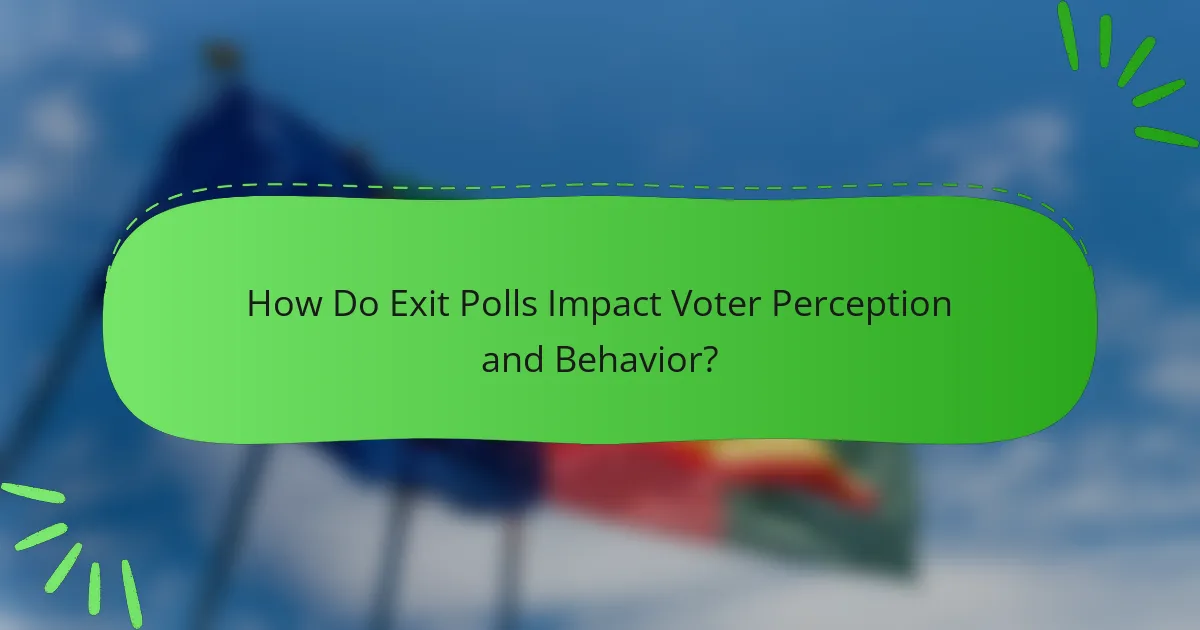Exit polls are surveys conducted with voters immediately after they cast their ballots, aiming to predict election outcomes and analyze voter behavior. This article examines the methodology and significance of exit polls in U.S. elections, highlighting their historical context since the 1960s and their influence on media coverage and public perception. Key factors affecting the accuracy of exit polls, such as sample size, timing, voter turnout, and demographic representation, will be discussed. Additionally, the article explores how exit polls can shape voter decisions and impact turnout, including the phenomenon of the bandwagon effect, where voters may shift their support based on perceived trends. Overall, the role of exit polls in the electoral landscape is critically analyzed.

What are Exit Polls and How Are They Conducted?
Exit polls are surveys conducted with voters immediately after they have cast their ballots. These polls aim to predict election outcomes and understand voter behavior. They typically involve asking a sample of voters about their choices and demographics. Exit polls are conducted at polling places across various locations. Trained interviewers approach voters as they leave the polling station. The collected data is then analyzed to provide insights into voting trends. Exit polls have been used in U.S. elections since the 1960s. They can influence media coverage and public perception of election results.
What is the purpose of exit polls in US elections?
The purpose of exit polls in US elections is to gauge voter behavior and predict election outcomes. Exit polls are conducted immediately after voters leave polling places. They collect data on how individuals voted and their demographic information. This information helps analysts understand trends and patterns in voting behavior. Additionally, exit polls can provide early insights into the election results before official counts are available. Historically, they have been used to forecast outcomes and identify key issues influencing voters. For instance, in the 2020 election, exit polls indicated that 51% of voters prioritized the economy. This data can influence media coverage and public perception of the election.
How do exit polls differ from other polling methods?
Exit polls differ from other polling methods by collecting data immediately after voters cast their ballots. They specifically target individuals leaving polling places to gather real-time insights on voting behavior. Unlike traditional polls, which may survey individuals days or weeks before an election, exit polls provide immediate feedback on election outcomes. This method aims to predict results and understand voter demographics. According to the National Election Pool, exit polls can accurately reflect voter preferences, as they capture opinions at the moment of decision. Other polling methods, such as phone or online surveys, may not achieve the same level of immediacy or context.
What methodology is used in conducting exit polls?
Exit polls utilize a systematic methodology to gather data on voter behavior. Interviewers are stationed at polling places to survey voters as they exit. The methodology typically involves random sampling to ensure a representative demographic. Respondents are asked about their voting choices and demographic information. Data is then aggregated and analyzed to project election outcomes. The accuracy of exit polls depends on sample size and response rates. Historical data supports that well-conducted exit polls can closely predict election results.
Why are exit polls significant in analyzing election outcomes?
Exit polls are significant in analyzing election outcomes because they provide immediate insights into voter behavior. These polls are conducted as voters leave polling places. They capture demographic information and voting preferences. This data helps predict election results before official counts are available. In the 2020 U.S. presidential election, exit polls indicated key trends in voter turnout. For example, they showed increased participation among younger voters. This information can guide political strategies and media coverage. Additionally, exit polls can highlight discrepancies between predicted and actual results, prompting further analysis. Overall, they serve as a crucial tool for understanding electoral dynamics.
What insights do exit polls provide about voter behavior?
Exit polls provide critical insights into voter behavior by revealing demographic trends and preferences. They gather data immediately after voters cast their ballots. This data reflects how different groups voted based on age, gender, race, and education. For example, in the 2020 election, exit polls indicated that 51% of women voted for Joe Biden. Conversely, 53% of men supported Donald Trump. These statistics highlight shifts in party alignment among various demographics. Additionally, exit polls can indicate issues that influenced voter decisions, such as healthcare or the economy. They also help predict election outcomes and inform campaign strategies. Thus, exit polls serve as a valuable tool for understanding and analyzing voter behavior in elections.
How do exit polls influence media coverage of elections?
Exit polls significantly influence media coverage of elections by providing early insights into voter behavior. Media outlets use these polls to project outcomes before official results are available. This can shape public perception and narrative surrounding the election. For instance, if exit polls indicate a strong lead for a candidate, media coverage may focus on that candidate’s potential victory. Conversely, if polls show a tight race, coverage might emphasize uncertainty and tension. Historical examples, such as the 2000 presidential election, illustrate how exit polls can lead to premature calls for candidates. Additionally, exit polls can inform analysis and commentary, guiding discussions on voter demographics and trends. This influence underscores the role of exit polls in framing the electoral narrative.

What Factors Affect the Accuracy of Exit Polls?
The accuracy of exit polls is affected by several key factors. Sample size is crucial; larger samples generally yield more reliable results. The timing of the polling also matters; polls conducted too early may not capture last-minute voter decisions. Voter turnout can influence accuracy; unexpected turnout levels can skew results. Additionally, demographic representation in the sample is vital; unbalanced samples can lead to biased outcomes. Respondent honesty plays a role; if voters are reluctant to disclose their choices, accuracy declines. Methodology used in conducting the poll, including question phrasing, can impact responses. Historical data shows that these factors have led to significant discrepancies in past elections, underscoring the complexity of predicting outcomes through exit polls.
How does sample size impact the reliability of exit polls?
Sample size significantly impacts the reliability of exit polls. A larger sample size generally leads to more accurate results. This is because a larger group better represents the overall population. Smaller samples can introduce higher margins of error. For instance, a sample size of 1,000 voters may yield a margin of error of about 3%. Conversely, a sample size of 100 voters could result in a margin of error closer to 10%. Therefore, reliability increases with sample size, as it reduces the likelihood of random sampling errors. Historical data shows that larger exit polls have more consistent predictive accuracy in elections.
What demographic factors are considered in exit polling?
Exit polling considers several demographic factors. These factors include age, gender, race, education level, and income. Each demographic plays a critical role in understanding voter behavior. For instance, age can influence political preferences, with younger voters often leaning towards progressive policies. Gender differences also affect voting patterns, as women and men may prioritize different issues. Race is another significant factor, as voting trends can vary widely among different ethnic groups. Education level often correlates with voting choices, where higher education may lead to different political affiliations. Income levels can impact voter priorities, influencing decisions based on economic concerns. These demographic factors are essential for analyzing and interpreting exit poll results accurately.
How does timing affect the accuracy of exit polls?
Timing significantly affects the accuracy of exit polls. Early exit polls may not capture the final voting trends. Voter turnout can fluctuate throughout the day, impacting the demographic representation in early polls. For instance, morning voters may differ in preferences from those voting later. Additionally, late-breaking news can influence voter decisions, skewing results if polls close too soon. Historical data shows that exit polls often underestimate support for candidates in close races. The 2004 U.S. presidential election exit polls, for example, inaccurately predicted outcomes due to timing issues. Thus, the timing of data collection plays a crucial role in the reliability of exit poll results.
What challenges do exit pollsters face in data collection?
Exit pollsters face several challenges in data collection. One major challenge is obtaining a representative sample of voters. This is difficult due to varying voter turnout across demographics. Another challenge is the timing of data collection. Pollsters must conduct interviews immediately after voters leave polling places. This can lead to limited responses if voters are in a hurry. Additionally, social desirability bias can affect responses. Voters may not disclose their true preferences due to fear of judgment. Weather conditions and location accessibility can also hinder data collection efforts. Furthermore, technological issues may arise with electronic data collection methods. These challenges can impact the accuracy of exit poll results significantly.
How do election day variables impact exit poll results?
Election day variables significantly impact exit poll results by influencing voter turnout and responses. Factors such as weather conditions can affect the number of voters who participate. For instance, inclement weather may deter voters, leading to lower turnout in specific demographics. Additionally, the timing of voting can play a role; early voters may differ in their preferences compared to those who vote later in the day.
Moreover, the presence of high-profile races can alter voter enthusiasm and engagement levels. This can skew the demographics of those participating in exit polls. Historical data indicates that in elections with competitive races, exit poll results tend to align more closely with actual outcomes. Conversely, in less competitive elections, exit polls may misrepresent voter sentiment.
The accuracy of exit polls is also affected by the methodology used, such as sampling techniques and question phrasing. These variables collectively shape the reliability of exit poll results, highlighting the importance of considering them when analyzing electoral outcomes.
What role does technology play in modern exit polling?
Technology plays a crucial role in modern exit polling. It enables faster data collection and analysis. Electronic devices, such as tablets and smartphones, facilitate real-time surveys. This technology allows pollsters to reach a larger and more diverse sample of voters. Advanced statistical methods are applied through software to interpret the data accurately. Additionally, social media platforms help in disseminating exit poll results quickly. The use of technology enhances the reliability of the information gathered. Studies show that technology-driven exit polls have increased accuracy in predicting election outcomes.

How Do Exit Polls Impact Voter Perception and Behavior?
Exit polls significantly influence voter perception and behavior. They provide immediate feedback on election outcomes, shaping public opinion. Voters may alter their choices based on perceived trends. For example, if exit polls indicate a candidate’s strong performance, undecided voters may lean toward that candidate. Research shows that early results can create a bandwagon effect, where voters support a leading candidate. A study by the Pew Research Center found that 55% of voters were influenced by exit polls in their decisions. Additionally, exit polls can affect voter turnout, as individuals may feel motivated to vote if they believe their candidate is winning. Overall, exit polls play a crucial role in shaping the electoral landscape.
What is the relationship between exit polls and voter turnout?
Exit polls can influence voter turnout. They provide early insights into election outcomes. These insights may affect voters’ perceptions of their candidate’s viability. If exit polls show a candidate leading, supporters may feel encouraged to vote. Conversely, if a candidate is trailing, some voters may lose motivation to participate. Research indicates that exit polls can create a bandwagon effect. This effect can lead to increased turnout for perceived winning candidates. A study by the Pew Research Center found that polls can sway undecided voters. This demonstrates the significant relationship between exit polls and voter turnout.
How can exit polls create a bandwagon effect among voters?
Exit polls can create a bandwagon effect among voters by influencing perceptions of candidate viability. When exit polls show a leading candidate, voters may feel compelled to support that candidate. This is often driven by the desire to align with perceived winners. Research indicates that voters are more likely to change their votes based on publicized polling results. A study by the Pew Research Center found that 50% of voters reported being influenced by polls. This can lead to increased support for candidates perceived as front-runners. As more voters jump on the bandwagon, it can further solidify the leading candidate’s position. Thus, exit polls can significantly shape voter behavior and election outcomes.
What psychological factors influence voter reactions to exit poll results?
Psychological factors influencing voter reactions to exit poll results include cognitive biases, social identity, and emotional responses. Cognitive biases, such as confirmation bias, lead voters to interpret exit polls in a way that aligns with their pre-existing beliefs. Social identity affects how voters perceive poll results based on group affiliations, influencing their reactions to perceived threats or affirmations of their identity. Emotional responses, including anxiety or excitement, can amplify reactions to exit polls, impacting voter behavior and turnout. Research indicates that these psychological factors significantly shape electoral dynamics, as voters often adjust their expectations and decisions based on exit poll outcomes.
How do exit polls contribute to post-election analysis?
Exit polls provide immediate data on voter preferences and behaviors after an election. They help analysts understand how different demographics voted. This information can reveal trends in voting patterns. For instance, exit polls may show shifts in support among age groups or ethnicities compared to previous elections. They also contribute to the accuracy of election forecasts. By comparing exit poll data with actual results, analysts can assess the reliability of polling methods. Historical data from exit polls has informed strategies for future campaigns. In 2020, for example, exit polls indicated significant turnout among young voters, influencing party outreach efforts.
What trends can be identified through historical exit poll data?
Historical exit poll data reveals trends in voter demographics and preferences. These polls often show shifts in party affiliation over time. For example, data from the 2020 election indicated a growing support for Democrats among suburban voters. Additionally, exit polls highlight differences in voting behavior based on race, age, and gender. In 2016, exit polls showed that white voters favored Trump, while minority voters largely supported Clinton. Trends also illustrate changes in voter turnout, particularly among younger voters in recent elections. Historical data can indicate the impact of key issues on voter choices, such as the economy or healthcare. Overall, exit poll data provides valuable insights into evolving electoral dynamics in the U.S.
How do exit polls inform future electoral strategies for candidates?
Exit polls provide candidates with valuable insights into voter preferences and behaviors. They reveal demographic trends and voting patterns among different groups. Candidates analyze this data to adjust their campaign strategies. For instance, if exit polls show strong support among young voters, candidates may focus on issues that resonate with that demographic. Additionally, exit polls can highlight areas where candidates are losing support. This information allows for targeted outreach efforts. Historical data from past elections shows that candidates who adapt their strategies based on exit poll data often perform better in subsequent elections. Therefore, exit polls serve as a crucial tool for refining electoral strategies.
What Best Practices Should Be Followed in Interpreting Exit Polls?
Best practices in interpreting exit polls include understanding their methodology and context. Analysts should consider sample size, which affects reliability. A larger sample size typically yields more accurate results. It’s crucial to recognize that exit polls reflect a snapshot in time. Results may change as more votes are counted. Analysts must also be aware of margin of error, which indicates the potential variability in results. Additionally, demographic breakdowns provide insight into voting trends. Comparing exit poll data with actual election results can validate findings. Finally, being cautious of overinterpretation is essential, as exit polls are not definitive.
Exit polls are surveys conducted with voters immediately after they cast their ballots, aiming to predict election outcomes and analyze voter behavior. This article examines the methodology, significance, and challenges of exit polls in U.S. elections, highlighting their role in shaping media coverage and influencing voter perceptions. Key factors affecting the accuracy of exit polls, such as sample size and timing, are discussed, along with the psychological impacts on voter behavior. Additionally, the article explores how historical exit poll data informs future electoral strategies and trends in voter demographics.